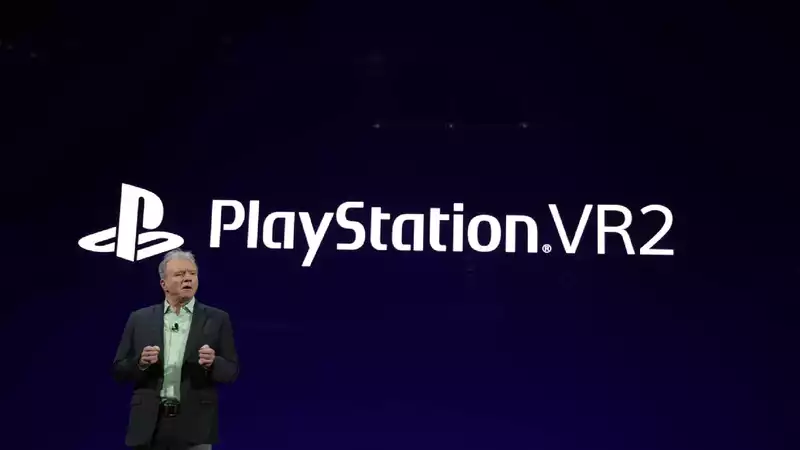During the CES 2022 keynote, Sony finally revealed the full specifications of the PSVR 2 virtual reality headset for PS5 and confirmed the actual name of this device.
The official name for PSVR 2 will be, drum roll please, PlayStation VR 2. While this is a rather anticlimactic announcement, it makes sense that Sony would stick with the most logical name, since that's what we've been calling this unannounced device for the past 12 months.
One aspect of the device that certainly cannot be described as a letdown is the confirmed spec sheet. Despite some exciting hints and leaks in the past, it turns out that the PS5 peripheral blows the previous model out of the water. For more details on the differences, see our comparison between PSVR 2 and PSVR.
After announcing some fresh details at CES 2022, the PlayStation Blog published an article summarizing many new details. (Perhaps Sony missed a big opportunity to reveal Project Spartacus at CES 2022, but that's another story.)
For starters, it was confirmed that the device will be called PSVR 2, as well as that the orbital controller previously shown will be known as the PlayStation VR2 Sense controller.
The blog post also noted the improvements PSVR 2 will offer over the original PSVR headset, which launched in 2016. The next-generation headset will feature 4K resolution, HDR support, and a 110-degree viewing angle, which will significantly improve visual fidelity.
Rumors that PSVR 2 will feature a 4K OLED display have been confirmed, with an expected resolution of 2000x2040 per eye (a significant leap from the original PSVR's 960x1080 per eye). The headset will support frame rates of up to 120 Hz.
Foveated rendering, which reduces the detail of assets in the peripheral vision to maximize available power, has also been confirmed. The device will provide headset-based controller tracking through a camera built into the VR headset itself, which will also allow for eye tracking.
Sony mentioned the PSVR 2's impressive range of sensory features. Headset feedback is a major addition, with one built-in motor adding vibration to the headset. This can, for example, simulate the sensation of an object passing close to the head. This is complemented by 3D audio technology and the haptic feedback and adaptive triggers provided by the PSVR 2 Sense controller.
Frustratingly, Sony did not conclude this deep dive with information on the PSVR 2's price and release date (and has yet to really show us what the headset will look like). However, from the specs we expect a launch price of $400 to $500, and recent reports suggest that the headset is currently on track for a 2022 launch, as it is scheduled to go into mass production soon.
I can say that Sony has blown away my (rather modest) expectations by revealing the full specs of the PSVR 2. I've certainly been interested in the headset for some time, but now I'm fully on board. If I could pre-order one, I would 100% adopt it from day one.
The difference such a dramatic leap in resolution makes (from 960x1080 on one eye to 2000x2040 on the other) cannot be overstated. While I enjoy using my current PSVR, I have serious eyestrain issues due to the low image quality. As a result, I tend to get severe headaches after 45 minutes of play. Thankfully, this should not be an issue with PSVR 2.
Improvements to the way the headset actually tracks the user would also be welcome. The original PSVR used a single-camera, light-based tracking system that was quite unreliable, to say the least; PSVR 2 abandons that in favor of a headset/controller-based tracking system that is more accurate and does not require a TV-mounted camera It uses a headset/controller-based tracking system that is more accurate and does not require a TV-mounted camera. In addition, users will actually be able to turn their face away from the TV while fully immersed in the virtual world.
Sony has again confirmed that PSVR 2 will employ a streamlined, single-cable setup process; actually connecting the PSVR to the console requires the use of half a dozen cables and a dedicated breakout box, so I often I neglect to play it. I've seen some complaints online about the lack of wireless support, but I can understand why Sony wouldn't go that route, as it would significantly increase the price.
We are also happy to see that Sony has announced the first flagship exclusive title for PSVR 2, Horizon Call of the Moutain. A VR spin-off of the popular Horizon series, Call of the Moutain will probably be coming to PSVR around launch. A great headset is nothing without great software to play on it, so it's nice to see that Sony is already putting resources into creating high-quality VR experiences.
PSVR 2 will not be the most powerful VR headset on the market Currently available devices like the HTC Vive Pro 2 already beat PSVR, but that is clearly not where PSVR stands in the market PSVR does not have a powerful PC setup It is a more accessible VR headset designed for gamers. In that regard, PSVR 2 offers more than anyone could reasonably expect.
At this point, my only hesitation in purchasing the PSVR 2 comes from the inevitability of stock shortages; let's not forget that the PS5 is still extremely difficult to find, even more than a year after its release. Hopefully I'll be lucky and won't have to search for months for inventory to get my hands on a PSVR 2.
.









Comments